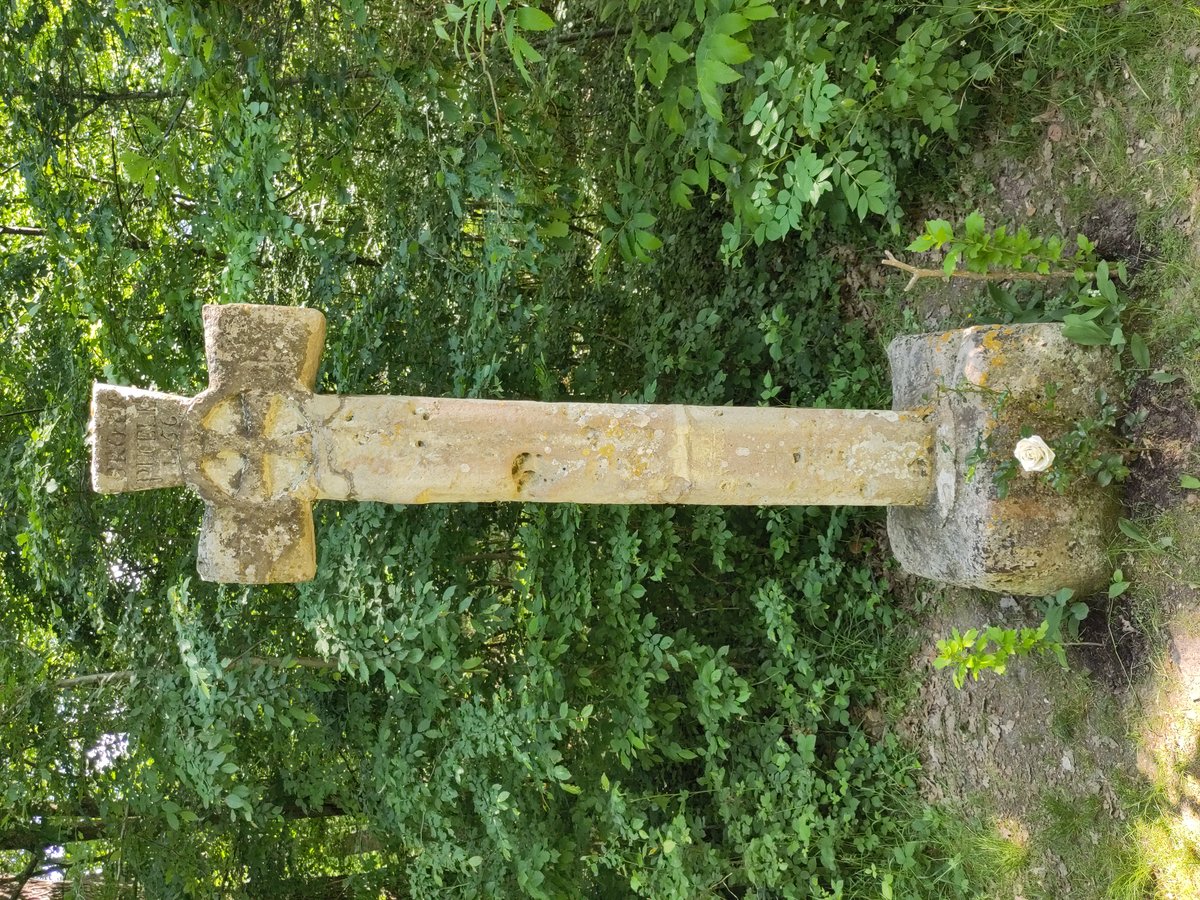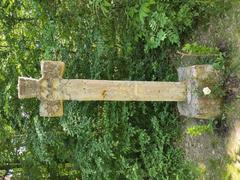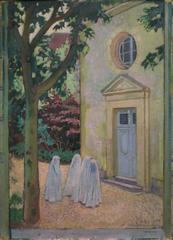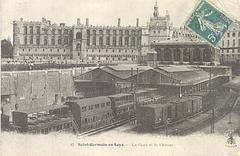
Croix Pucelle Visiting Hours, Tickets, and Comprehensive Guide to Saint-Germain-en-Laye Historical Sites
Date: 14/06/2025
Introduction: Unveiling the Croix Pucelle’s Historical Legacy
Located within the storied town of Saint-Germain-en-Laye, the Croix Pucelle is a remarkable 15th-century wayside cross that stands as a testament to France’s medieval heritage and spiritual traditions. Erected in 1456, the monument honors the rehabilitation of Joan of Arc, “La Pucelle d’Orléans,” symbolizing justice, faith, and national reconciliation after the Hundred Years’ War. Its striking Gothic craftsmanship, religious iconography, and position near the Château de Saint-Germain-en-Laye and the Forêt de Saint-Germain-en-Laye make it an accessible and evocative destination for visitors of all backgrounds.
Saint-Germain-en-Laye itself boasts a rich royal history, with a picturesque old town, vibrant markets, and the renowned château—birthplace of Louis XIV. The adjacent forest, once a royal hunting ground, adds a layer of natural beauty to the historical experience. Whether you’re drawn to the Croix Pucelle’s symbolism, its architecture, or the opportunity to explore scenic trails, this guide provides detailed information on visiting hours, accessibility, nearby attractions, and practical tips to ensure a rewarding visit.
With no entrance fee and open access during daylight hours, the Croix Pucelle invites travelers to engage with living history, enhanced by guided tours, cultural events, and photographic opportunities. Discover why this emblematic monument remains a cherished part of Saint-Germain-en-Laye’s cultural tapestry (Commune Mairie, Montjoye, Actu.fr).
Contents
- Introduction
- Why Visit the Croix Pucelle?
- Practical Information: Visiting Hours, Tickets & Accessibility
- Historical Background and Symbolism
- Cultural and Local Significance
- Guided Tours and Photography
- Nearby Attractions
- Frequently Asked Questions (FAQ)
- Practical Tips
- Conclusion
Why Visit the Croix Pucelle?
The Croix Pucelle is a unique survivor of France’s medieval past. As an outdoor monument set at a crossroads near the château and the forest, it offers a rare glimpse into the religious, social, and political dynamics of the 15th century. Its enduring presence marks it as both a historical and spiritual landmark, and its accessibility makes it suitable for all types of visitors—from history buffs to casual strollers.
Practical Information: Visiting Hours, Tickets & Accessibility
- Visiting Hours: The Croix Pucelle is accessible outdoors, year-round, during daylight hours. There are no gates or restrictions, but it’s best visited during the day for visibility and safety.
- Tickets: Admission is free; no tickets or reservations are required.
- Accessibility: The site is located on generally level ground near main walking trails. While the area is accessible for most visitors, those with limited mobility should note that some adjacent forest paths may be uneven. For detailed accessibility advice, contact the Saint-Germain-en-Laye tourist office.
- How to Get There: Easily reachable by foot from the Château de Saint-Germain-en-Laye or town center. The RER A train from Paris arrives at Saint-Germain-en-Laye station, from which the monument is a short walk away. Parking is available at several forest access points (Actu.fr).
Historical Background and Symbolism
Origins and Rehabilitation of Joan of Arc
Commissioned in 1456 by Jean d’Orléans, Count of Dunois and companion of Joan of Arc, the Croix Pucelle commemorates the annulment of Joan’s heresy conviction and the restoration of her honor. The term “pucelle” refers to a young girl in medieval French, linking the monument to Joan’s legendary status (Montjoye).
Architectural Features
The cross typifies late Gothic stonework, with a slender shaft and sculpted cross adorned with religious motifs. Its placement near major medieval routes underlines its role as both a spiritual and social marker.
Layered Meanings
Beyond its association with Joan of Arc, local tradition attributes the cross to other events, such as a tragic forest incident in 1423. Whether as a site of commemoration or a warning, the Croix Pucelle embodies the complexity of local memory (Montjoye).
Survival and Restoration
Damaged during the French Revolution, the cross was restored in 1850, symbolizing France’s shifting attitudes toward its religious and historical legacy. Its continued maintenance affirms its recognized status as a protected historical monument (Flickr).
Cultural and Local Significance
The Croix Pucelle stands at the intersection of faith, local identity, and national history. It has functioned as a waymark, parish boundary, and gathering point for centuries. Its location—on the ancient “chemin de Poissy”—reflects the importance of travel, pilgrimage, and the imposition of social order in the medieval landscape.
The monument’s endurance through wars, revolutions, and changing times speaks to its resilience and the reverence with which it is regarded in Saint-Germain-en-Laye. Special commemorative events, such as the anniversary of Joan of Arc’s rehabilitation, are occasionally held at the site.
Guided Tours and Photography
- Guided Tours: The Saint-Germain-en-Laye tourist office and local heritage groups offer walking tours that feature the Croix Pucelle alongside other significant landmarks, including the château, churches, and old town streets.
- Photography Tips: Best lighting conditions occur during early morning and late afternoon. The cross, set against the forest or the historic townscape, provides striking photographic opportunities.
Nearby Attractions
Saint-Germain-en-Laye offers a wealth of attractions within walking distance of the Croix Pucelle:
- Château de Saint-Germain-en-Laye: Home to the National Archaeological Museum, with extensive collections and beautiful gardens (French Moments).
- Forêt de Saint-Germain-en-Laye: Expansive woodland ideal for walking, cycling, and picnicking.
- Historic Old Town: Explore Rue au Pain, Place du Marché Neuf, and traditional cafés (France-Voyage).
- Musée départemental Maurice Denis: Focused on the Symbolist painter and his era.
- Maison Debussy: Museum dedicated to the famed composer.
- Other Forest Oratories and Crosses: The Sentier des Oratoires trail connects several historic and spiritual sites (Actu.fr).
Frequently Asked Questions (FAQ)
Q: What are the opening hours for the Croix Pucelle?
A: The site is open year-round, accessible at any time during daylight.
Q: Is there an entrance fee?
A: No, access to the Croix Pucelle is free.
Q: How do I get there?
A: On foot from the town center or château, or by public transport followed by a short walk.
Q: Are guided tours available?
A: Yes, check with the local tourist office for tour schedules.
Q: Is the site accessible for people with disabilities?
A: The monument is on generally level ground, but some areas nearby may be uneven. Visitors with mobility needs should inquire further in advance.
Practical Tips
- What to Bring: Comfortable shoes, water, and a camera. Dress for the weather and consider a map or GPS for forest trails.
- Navigation: The Sentier des Oratoires is marked by blue crosses and offers a structured route for exploring related sites.
- Facilities: No amenities at the monument itself; public toilets and dining options are available in the town.
- Safety: The area is considered safe, but always inform someone of your route if hiking alone.
Conclusion
The Croix Pucelle is a living symbol of France’s enduring heritage—blending medieval history, spiritual significance, and local legend. Its accessibility, evocative setting, and integration with the broader historical and natural landscape of Saint-Germain-en-Laye make it a must-visit for anyone interested in France’s rich past. Enhance your experience by exploring surrounding attractions, joining a guided tour, and taking advantage of local events and markets.
For the latest information, interactive maps, and personalized travel suggestions, download the Audiala app. Explore more articles about Saint-Germain-en-Laye’s sites and follow us for travel inspiration and updates. Plan your trip today and let the Croix Pucelle be the starting point for an unforgettable journey into French history.
Image suggestion:
Photo of the Croix Pucelle in Saint-Germain-en-Laye, with alt text: “15th-century Croix Pucelle stone cross framed by the forest”.
Interactive map:
[Embed a map highlighting the Croix Pucelle, Château de Saint-Germain-en-Laye, and major trailheads]
Further Reading and Official Sources
- Commune Mairie: Croix Pucelle Saint-Germain-en-Laye: Visiting Hours, Tickets & Historical Guide
- Montjoye: Visiting the Croix Pucelle: History, Tickets, and Travel Tips for Saint-Germain-en-Laye
- Actu.fr: Croix Pucelle Visiting Hours, Trail Guide, and Historical Insights near Saint-Germain-en-Laye
- French Moments: Croix Pucelle and Saint-Germain-en-Laye: Visiting Hours, Tickets, and Historical Sites Guide




